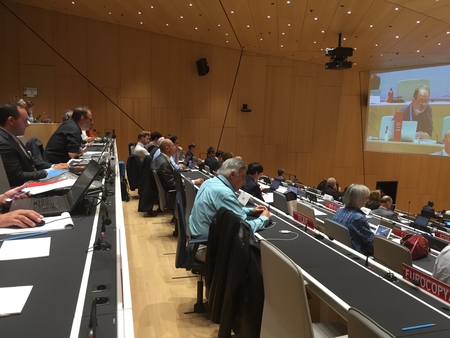Real progress has apparently been made in the definitions debate, but only after committee chairman Martin Moscoso (affectionately known around here as ‘the hero of Marrakesh’ after a similar tactic he deployed in 2013 gave the stalled negotiations a shot in the arm to deliver the Marrakesh Treaty) persuaded delegates to move the discussion to an informal session.
Of course, no one expected a unified text this week, but there is a palpable sense of optimism now that things are actually moving forward.
Before the agenda moved to exceptions and limitations, the International Federation of Libraries and Archives (IFLA) hosted a lunchtime side event for all present. This was a moment for archivists and librarians to appeal for copyright laws that cut them some more slack, in particular when it comes to digitization projects.
In building their case, Victoria Owen, of the Canadian Library Association, sought to discredit the famous PwC 2015 report Economic Impacts of the Canadian Educational Sector’s Fair Dealing Guidelines, which describes current and future harmful consequences of the 2012 changes to Canadian copyright law that included education in fair dealing exceptions.
Ms Owen said the report was “misleading” and short on evidence, citing a footnote caveat that reads: “substantial quantitative data regarding the majority of the economic impacts is not yet available”. But this caveat was included because when the report was produced the Guidelines were still quite new, and that once other school licensing agreements had expired “the impacts of the Guidelines are expected to manifest more intensely”. And we understand from Canadian publishers that this is the case.
In a measured response, Bill Harnum of the Canadian Copyright Institute pointed to the recent closure of the Oxford University Press educational division in Canada and the drying up of royalties for authors and publishers from sources in Canada, and the absence of permissions requests from any source in Canada – despite continuing permissions requests from the US – placing the blame for these developments squarely on the new fair dealing exceptions.
Harnum also gently reminded Ms Owen that the Guidelines were not based on law, a point he raised during SCCR 30. During that intervention, he pointed out that the Guidelines recommend that educators be allowed to copy up to 10% of an entire copyrighted work, or one complete chapter, or a complete journal article, or a complete poem, without having to seek permission. This is what Canadian educators and librarians would like the law to be, and how they behave.
The afternoon session opened with a fascinating slide presentation by Singaporean professor Daniel Seng, the written version of which can be accessed here, where he gave a comprehensive overview of the global state of play regarding exceptions and limitations for educational activities.
Responding to the report, IPA Secretary General José Borghino made an intervention
where he congratulated the professor on a monumental piece of research, and noted that its national focus was aligned to the IPA’s belief that the most successful educational systems are based on local authors working with local publishers to produce high quality, locally relevant content.

